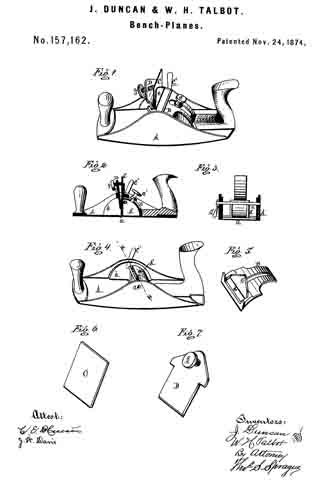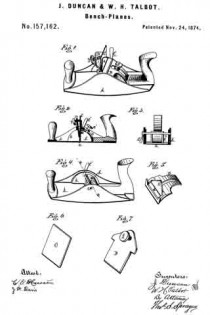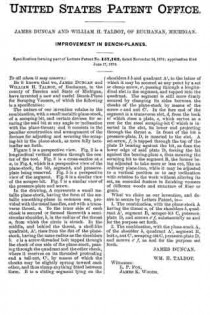No. 157,162 – Improvement In Bench-Planes (James Duncan And William H. Talbot) (1874)

UNITED STATES PATENT OFFICE.
_________________
JAMES DUNCAN AND WILLIAM H. TALBOT, OF BUCHANAN, MICHIGAN.
IMPROVEMENT IN BENCH-PLANES.
_________________
Specification forming part of Letters Patent No. 157,162, dated November 24, 1874; application filed June 17, 1874.
_________________
To all whom it may concern:
Be it known that we, JAMES DUNCAN and WILLIAM H. TALBOT, of Buchanan, in the county of Berrien and State of Michigan, have invented a new and useful Bench-Plane for Scraping Veneers, of which the following is a specification:
The nature of our invention relates to the combination, with a small metallic plane-stock, of a scraping-bit, and certain devices for securing the said bit at any angle or inclination with the plane-throat; and it consists in the peculiar construction and arrangement of the devices for adjusting and securing the scraping-bit in the plane-stock, as more fully hereinafter set forth.
Figure 1 is a perspective view. Fig. 2 is a longitudinal vertical section through the center of the tool. Fig. 3 is a cross-section at x x, in Fig. 4, which is a perspective view of the plane-stock, the bit, segment, and pressure-plate being removed. Fig. 5 is a perspective view of the segment. Fig. 6 is a similar view of the scraper-bit. Fig. -7 is a similar view of the pressure-plate and screw.
In the drawing, A represents a small metallic plane-stock, having the form of the metallic smoothing-plane in common use, provided with the usual handles, and with a transverse throat, a. To the inner side of each cheek is secured or formed therewith a semi-circular shoulder, b, in the radius of the throat a, from which the circle is struck. In the middle, and behind the throat, a shell-like quadrant, A’, rises from the flat of the plane-stock, having the same radius as the shoulders b. c is a screw-threaded bolt tapped through the cheek of one side of the plane-stock, passing through the quadrant and the other cheek, where it receives on its threaded protruding end a tail-nut, C’, by means of which the cheeks may be slightly sprung toward each other, and thus clamp anything fitted between them. B is a sliding segment lying on the shoulders b b and quadrant A’, to the latter of which it may be secured at any point by a set or clamp screw, c’, passing through a longitudinal slot in the segment, and tapped into the quadrant. The segment is still more firmly secured by clamping its sides between the cheeks of the plane-stock by means of the screw c and nut C’. In the fore end of the segment is a transverse slot, d, from the back of which rises a plate, e, which serves as a rest for the steel scraping-bit C which is inserted in the slot, its lower end projecting through the throat a. In front of the bit a pressure-plate, D, is inserted in the slot. A set-screw, f, is tapped through the top of the plate D bearing against the bit, as does the lower edge of said plate D, forcing the bit against the bearing-plate e, thus securing the scraping-bit to the segment B, the former being adjusted to take more or less cut, like an ordinary plane-iron, while it may be adjusted to a vertical position or to any inclination with relation to the work without altering its set, an essential feature in finishing veneers of different woods and structure of fiber or grain.
What we claim as our invention, and desire to secure by Letters Patent, is —
1. The combination, with the plane-stock A having the throat a, of the shoulders b, quadrant A’, segment B, scraper-bit C, pressure-plate D, and screws c’ f, substantially as and for the purpose set forth.
2. The combination, with the plane-stock A, of the shoulder b, quadrant A’, segment B, bolt c, nut C’, scraping-bit C, pressure-plate D, and screws c’ f, as and for the purpose set forth.
JAMES DUNCAN.
WM. H. TALBOT.
Witnesses:
L. P. FOX,
JAMES K. WOODS.


